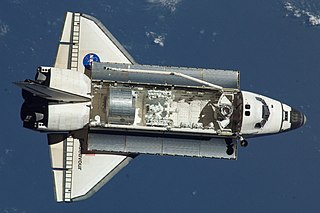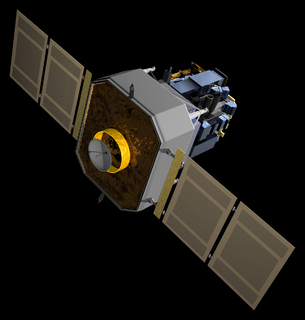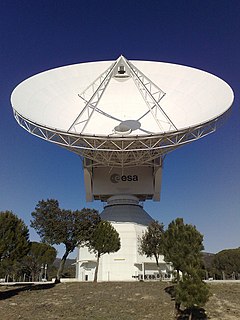
The International Space Station (ISS) is a modular space station in low Earth orbit. It is a multinational collaborative project involving five participating space agencies: NASA, Roscosmos (Russia), JAXA (Japan), ESA (Europe), and CSA (Canada). The ownership and use of the space station is established by intergovernmental treaties and agreements. The station serves as a microgravity and space environment research laboratory in which scientific research is conducted in astrobiology, astronomy, meteorology, physics, and other fields. The ISS is suited for testing the spacecraft systems and equipment required for possible future long-duration missions to the Moon and Mars.

Space Shuttle Endeavour is a retired orbiter from NASA's Space Shuttle program and the fifth and final operational Shuttle built. It embarked on its first mission, STS-49, in May 1992 and its 25th and final mission, STS-134, in May 2011. STS-134 was expected to be the final mission of the Space Shuttle program, but with the authorization of STS-135, Atlantis became the last shuttle to fly.

Ulysses is a decommissioned robotic space probe whose primary mission was to orbit the Sun and study it at all latitudes. It was launched in 1990 and made three "fast latitude scans" of the Sun in 1994/1995, 2000/2001, and 2007/2008. In addition, the probe studied several comets. Ulysses was a joint venture of NASA and the European Space Agency (ESA) with participation from Canada's National Research Council. The last day for mission operations on Ulysses was June 30, 2009.

The Canadian Space Agency is the national space agency of Canada, established in 1990 by the Canadian Space Agency Act. The agency is responsible to the minister of innovation, science, and economic development.

The Mobile Servicing System (MSS) is a robotic system on board the International Space Station (ISS). Launched to the ISS in 2001, it plays a key role in station assembly and maintenance; it moves equipment and supplies around the station, supports astronauts working in space, and services instruments and other payloads attached to the ISS and is used for external maintenance. Astronauts receive specialized training to enable them to perform these functions with the various systems of the MSS.

The Solar and Heliospheric Observatory (SOHO) is a spacecraft built by a European industrial consortium led by Matra Marconi Space that was launched on a Lockheed Martin Atlas II AS launch vehicle on December 2, 1995, to study the Sun. It has also discovered over 3,000 comets. It began normal operations in May 1996. It is a joint project between the European Space Agency (ESA) and NASA. Originally planned as a two-year mission, SOHO continues to operate after over 25 years in space; the mission has been extended until the end of 2020 with a likely extension until 2022.
The John H. Chapman Space Centre is the headquarters of the Canadian Space Agency. It is located in Longueuil, Quebec, Canada, in the borough of Saint-Hubert.

The Cupola is an ESA-built observatory module of the International Space Station (ISS). Its name derives from the Italian word cupola, which means "dome". Its seven windows are used to conduct experiments, dockings and observations of Earth. It was launched aboard Space Shuttle mission STS-130 on 8 February 2010 and attached to the Tranquility module. With the Cupola attached, ISS assembly reached 85 percent completion. The Cupola's central window has a diameter of 80 cm (31 in).

Canadarm or Canadarm1 is a series of robotic arms that were used on the Space Shuttle orbiters to deploy, maneuvre, and capture payloads. After the Space Shuttle Columbia disaster, the Canadarm was always paired with the Orbiter Boom Sensor System (OBSS), which was used to inspect the exterior of the Shuttle for damage to the thermal protection system.

Dextre, also known as the Special Purpose Dexterous Manipulator (SPDM), is a two armed robot, or telemanipulator, which is part of the Mobile Servicing System on the International Space Station (ISS), and does repairs otherwise requiring spacewalks. It was launched March 11, 2008 on mission STS-123.

The European Robotic Arm (ERA) is a robotic arm to be attached to the Russian segment of the International Space Station. It will be the first robot arm able to work on the Russian space station segments, and will supplement the two Russian Strela cargo cranes that are already installed on the Pirs module. The ERA is designed and assembled by Airbus Defence and Space Netherlands.

The Solar Orbiter (SolO) is a Sun-observing satellite, developed by the European Space Agency (ESA). SolO is intended to perform detailed measurements of the inner heliosphere and nascent solar wind, and perform close observations of the polar regions of the Sun, which is difficult to do from Earth, both serving to answer the question "How does the Sun create and control the heliosphere?"

The European Space Operations Centre (ESOC) in Darmstadt, Germany operates a number of ground-based space-tracking stations for the European Space Agency (ESA) known as the European Space Tracking (ESTRACK) network. The stations support various ESA spacecraft and facilitate communications between ground operators and scientific probes such as XMM-Newton, Mars Express, BepiColombo, Gaia. Similar networks are run by the USA, China, Russia, Japan, and India.

Cebreros Station is a European Space Agency, ESTRACK radio antenna station for communication with spacecraft, located about 10 km east of Cebreros and 90 km from Madrid, Spain, operated by the European Space Operations Centre and INTA. A 35-metre diameter antenna that receives and transmit in X- and Ka-bands is located at the site. Station code is "CEB". 20kW CW High Power Amplifier (HPA) it was created by Rheinmetall Italia SpA (Italy). The monitoring and control system was implemented by Microsis srl (Italy).
SPAR Aerospace was a Canadian aerospace company. It produced equipment for the Canadian Space Agency to be used in cooperation with NASA's Space Shuttle program, most notably the Canadarm, a remote manipulator system.

Grapple fixtures are used on spacecraft or other objects to provide a secure connection for a robotic arm.

The US Orbital Segment (USOS) is the name given to the components of the International Space Station (ISS) constructed and operated by the United States National Aeronautics and Space Administration (NASA), European Space Agency (ESA), Canadian Space Agency (CSA) and Japan Aerospace Exploration Agency (JAXA). The segment currently consists of eleven pressurized components and various external elements, all of which were delivered by the Space Shuttle.
Calian Group Ltd. is a Canadian company that was founded in 1982 as an Ottawa-based consulting firm. The company went public in 1993 and is traded on the Toronto Stock Exchange (TSX) under the symbol CGY.

Strela is a class of four Russian built cargo cranes used during EVAs to move cosmonauts and components around the exterior of the Soviet/Russian space station Mir and the Russian Orbital Segment of the International Space Station.

The European contribution to the International Space Station comes from 10 members of the European Space Agency (ESA) and amounts to an 8% share in the programme. It consists of a number of modules in the US Orbital Segment, ATV supply ships, launchers, software and €8 billion.


















